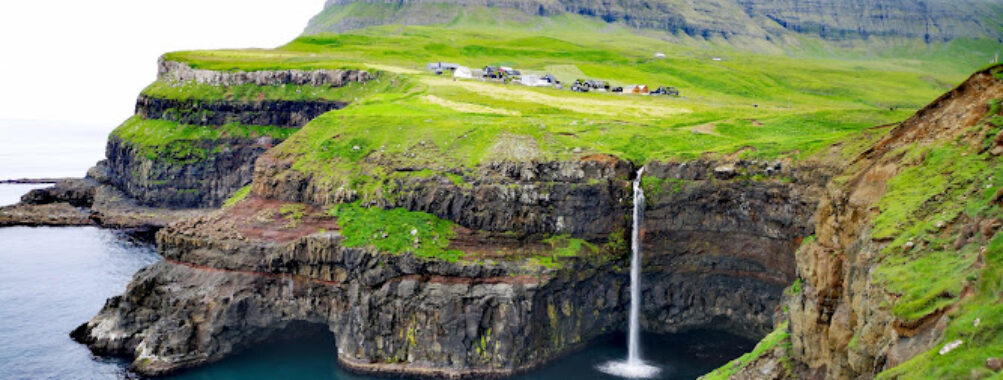
Múlafossur Waterfall
“`html
Table of Contents
Description
Múlafossur Waterfall is one of those places that feels almost unreal when you first see it. The way the water spills straight off the cliffs of Vágar Island and crashes into the Atlantic below—it’s something that sticks in your memory long after you’ve left. The small village of Gásadalur, tucked just behind the waterfall, adds a quiet, almost storybook charm to the scene. There’s a sense of isolation here, but not in a lonely way—more like stepping into a world that time forgot.
The waterfall itself isn’t massive by world standards, but its location makes it extraordinary. The contrast between the deep green cliffs, the dark basalt rock, and the white rush of water is mesmerizing. On clear days, you can even catch glimpses of Mykines Island in the distance, which makes the whole setting feel like a painting. I remember standing there once, camera in hand, realizing I hadn’t taken a single photo yet—I was too mesmerized just watching the mist drift across the cliffs.
It’s no surprise that Múlafossur has become one of the most photographed spots in the Faroe Islands. But what’s nice is that despite its fame, it rarely feels crowded. Travelers often describe a kind of calm that settles over them here, maybe because the sound of the waterfall drowns out everything else. It’s a place that invites you to slow down, breathe, and just take it all in.
Key Features
- Iconic coastal waterfall plunging directly into the North Atlantic Ocean
- Located beside the remote village of Gásadalur, surrounded by dramatic cliffs
- Accessible viewpoint offering panoramic views of the waterfall and ocean
- Popular photography and drone spot due to its unique setting
- Peaceful, uncrowded atmosphere even during peak travel months
- Family-friendly destination with easy access from the main road
- Nearby hiking trails, including the historic Postman’s Trail from Bøur
Best Time to Visit
Each season gives Múlafossur a completely different personality. In summer, the cliffs are bright green, and the long daylight hours make it perfect for photographers chasing that golden-hour glow. The air feels crisp and clean, and you’ll often see puffins and seabirds circling above.
Autumn brings deeper colors—rusty browns and burnt oranges—and sometimes a moody fog that rolls in from the sea. Honestly, that mist gives the whole place a mysterious, cinematic vibe. Winter, though colder and darker, can be truly magical. On rare clear nights, the Northern Lights sometimes appear above the waterfall, and the snow-dusted cliffs look like something straight out of a fantasy film.
Spring is underrated here. The waterfalls run strong from melting snow, and the village starts to come alive again after the quiet winter months. If you like fewer crowds and don’t mind a bit of unpredictable weather, late spring or early autumn might be your sweet spot.
How to Get There
Getting to Múlafossur used to be quite the adventure. Before a tunnel was built in 2004, locals had to hike over the mountains to reach Gásadalur—a journey that could take hours in unpredictable weather. These days, the drive is much easier, and honestly, it’s one of the most scenic routes in the Faroe Islands.
From Vágar Airport, it’s about a 15-minute drive west through winding roads that hug the coastline. The tunnel to Gásadalur opens up into a view that never fails to impress. There’s a small parking area near the village, and from there, it’s just a short walk to the viewpoint. The path is well-marked and suitable for most travelers, including families with children.
If you’re the adventurous type, consider hiking the old Postman’s Trail from the nearby village of Bøur. It’s about 5 kilometers one way and offers some of the most breathtaking views you’ll ever see. Just make sure to check the weather first—the trail can get slippery when wet.
Tips for Visiting
Here’s the thing about the Faroe Islands: the weather changes faster than you can say “Múlafossur.” One minute it’s sunny, the next it’s foggy or raining sideways. So, pack layers and waterproof gear, even if the forecast looks decent. I’ve learned that lesson the hard way—standing on the cliff with my camera wrapped in a plastic bag while the wind tried to steal my hat.
Early morning or late evening visits are ideal if you want to avoid the small tour groups that sometimes stop by midday. The light is softer then, and you’ll likely have the place almost to yourself. Bring a thermos of coffee or tea, sit on the rocks near the viewpoint, and just listen to the sound of the water hitting the ocean below—it’s strangely therapeutic.
For photographers, a tripod is worth carrying. The wind can be strong, so a sturdy one helps. And while drones are allowed, always check local regulations and respect the privacy of the villagers. They’re welcoming people, but this is still their home.
If you’re traveling with kids, you’ll be happy to know it’s a safe and easy spot to explore. Just keep an eye on them near the cliffs—there are no barriers between you and the drop.
Lastly, take your time. Don’t just snap a few photos and rush off. The magic of Múlafossur isn’t just in the view—it’s in the feeling of standing there, surrounded by sea, sky, and silence. It’s one of those rare places that reminds you how small you are in the best possible way.
So, whether you’re a photographer chasing the perfect shot, a traveler craving solitude, or simply someone curious about the Faroe Islands, Múlafossur Waterfall is worth every winding mile to get there. It’s not just another stop on a map—it’s an experience that stays with you long after you’ve left the cliffs behind.
“`
Location
Places to Stay Near Múlafossur Waterfall
Find and Book a Tour
Explore More Travel Guides
No reviews found! Be the first to review!